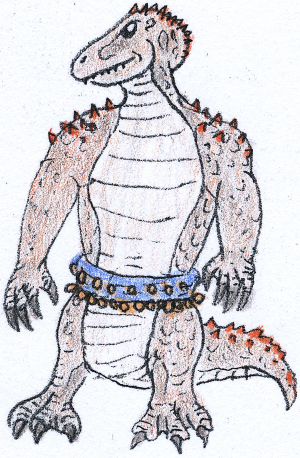Gláðs
The Gláðs1 are reptilian people inhabiting the Znagrúk Empire along with Hyrríans, Jeihókans, Úamtnants and Znagrúks. They inhabit the region around Ga River, and are traditional enemies of the Hyrríans, though nowadays the two tolerate each other so as not to anger the ruling Znagrúks.
The eyes are large, with pink, red or brown iris which is only clearly visible under certain conditions, otherwise they appear entirely black. The arms are far longer than the legs, the former have four clawed digits, while latter have three.
Gláðs are not as well adapted to the arid climate of the Múlíat Mountains as most other people there, and generally require more water, as their ancestors appeared when the area around Ga River was a swamp.
Animals are believed to be messenger of this creation deity, and young Gláðs are encouraged to travel to the wilderness and meditate on the behaviour of various animals to learn their connection with the deity.
Gláðs believe that the creator deity originally meant for them to be immortal, so he sent a spider to bring the good news to mortals, but the spider grew tired on the way and asked a scorpion to fulfill the task instead. Unfortunately, the scorpion was mistaken told the Gláðs they would be mortal instead, thus robbing them of the deity's gift. Ever since, spiders and scorpions have been feared and avoided by the Gláðs due to their association with death.
Appearance and abilities
Gláðs are only distantly related to other reptilian peoples of Dragonía, and are in fact slightly closer to mammals in certain respects; the teeth, for example, are not as uniform as those of other reptiles. They are quite tall and muscular, with brownish-grey scales -similar to that of crocodiles- covering most of their body and lighter ones protecting their throat, chest, belly, groin and underside of the tail, which is mostly used for balance. Rusty-red spikes cover the top and back of their head, shoulders back upper part of the tail.The eyes are large, with pink, red or brown iris which is only clearly visible under certain conditions, otherwise they appear entirely black. The arms are far longer than the legs, the former have four clawed digits, while latter have three.
Gláðs are not as well adapted to the arid climate of the Múlíat Mountains as most other people there, and generally require more water, as their ancestors appeared when the area around Ga River was a swamp.
Culture
Apparel
Gláð clothing is minimal and generally intended for decoration rather than as protection against the elements, consisting of little more than a sash around the waist, often adorned with small bronze pieces which jingle with every sudden movement. The sound is believed to ward off evil.Cuisine
Gláðs are almost entirely carnivorous, and use virtually every part of the animals they hunt, though they do use certain plants as medicine or to flavour food. They are also able to eat rotten meat up to certain extend without getting sick, though Gláð stomachs are not nearly as strong as those of Gobíls.Religion
Gláðs generally don't focus much on how the world came to being or what will become of it, most of their stories refer to some distant deity who created the world but usually doesn't concern themselves with mortals. This deity is associated with the sky, which was originally closer to the earth before the Gláðs discovered the secrets of fire-making therein, after which the sky was raised to its current height.Animals are believed to be messenger of this creation deity, and young Gláðs are encouraged to travel to the wilderness and meditate on the behaviour of various animals to learn their connection with the deity.
Gláðs believe that the creator deity originally meant for them to be immortal, so he sent a spider to bring the good news to mortals, but the spider grew tired on the way and asked a scorpion to fulfill the task instead. Unfortunately, the scorpion was mistaken told the Gláðs they would be mortal instead, thus robbing them of the deity's gift. Ever since, spiders and scorpions have been feared and avoided by the Gláðs due to their association with death.
Funeral practices
Gláð funerary rites are considered rather odd by other inhabitants of the Znagrúk Empire; the dead are wrapped in shrouds and buried in cairns outside settlements, then exhumed every ten years, given new shroud and then buried again. Traditionally, only those who knew the person well in life perform this ritual, so once they too pass away, the grave is left unattended.1Original icelandic: Gláðar, singular Gláði
Related Organizations
Znagrúk Empire
Languages spoken
Gláðic
Znagrúk Empire
Languages spoken
Gláðic
Geographic Distribution
Related Organizations




Comments